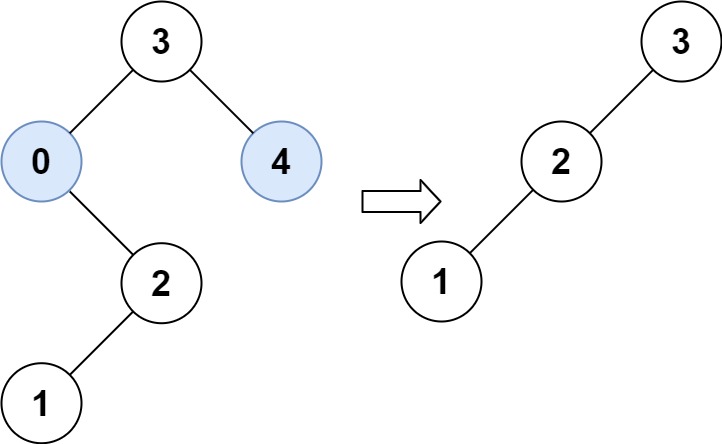- {x}
- Image Smoother
- Maximum Width of Binary Tree
- Equal Tree Partition
- Strange Printer
- Non-decreasing Array
- Path Sum IV
- Beautiful Arrangement II
- Kth Smallest Number in Multiplication Table
- Trim a Binary Search Tree
- Maximum Swap
- Second Minimum Node In a Binary Tree
- Bulb Switcher II
- Number of Longest Increasing Subsequence
- Longest Continuous Increasing Subsequence
- Cut Off Trees for Golf Event
- Implement Magic Dictionary
- Map Sum Pairs
- Read More...

Trim a Binary Search Tree
Given the root of a binary search tree and the lowest and highest boundaries as low and high, trim the tree so that all its elements lies in [low, high]. Trimming the tree should not change the relative structure of the elements that will remain in the tree (i.e., any node's descendant should remain a descendant). It can be proven that there is a unique answer.
Return the root of the trimmed binary search tree. Note that the root may change depending on the given bounds.
Example 1:

Input: root = [1,0,2], low = 1, high = 2 Output: [1,null,2]
Example 2:

Input: root = [3,0,4,null,2,null,null,1], low = 1, high = 3 Output: [3,2,null,1]
Constraints:
- The number of nodes in the tree is in the range
[1, 104]. 0 <= Node.val <= 104- The value of each node in the tree is unique.
rootis guaranteed to be a valid binary search tree.0 <= low <= high <= 104
Solution Explanation: Trim a Binary Search Tree
The problem asks to trim a Binary Search Tree (BST) such that only nodes with values within a given range [low, high] are retained. The relative structure of the remaining nodes should be preserved.
There are two main approaches to solve this problem:
Approach 1: Recursive Approach (DFS)
This approach uses Depth-First Search (DFS) to traverse the tree recursively. For each node:
- Base Case: If the current node is
null, returnnull. - Pruning: If the node's value is less than
low, recursively trim the right subtree (since values in the left subtree will also be less thanlow). If the node's value is greater thanhigh, recursively trim the left subtree (since values in the right subtree will also be greater thanhigh). - Recursive Calls: Recursively trim the left and right subtrees of the current node.
- Return: Return the current node (which is now part of the trimmed tree).
Time Complexity: O(N), where N is the number of nodes in the tree. Each node is visited at most once.
Space Complexity: O(H), where H is the height of the tree. This is due to the recursive call stack. In the worst case (a skewed tree), H can be N.
Approach 2: Iterative Approach
This approach iteratively trims the tree. It first adjusts the root to be within the range, then iteratively processes the left and right subtrees:
- Root Adjustment: It repeatedly moves the root pointer to its left or right child until the root's value falls within
[low, high]or the root becomesnull. - Left Subtree Trimming: It iterates down the left subtree, removing nodes with values less than
low. - Right Subtree Trimming: It iterates down the right subtree, removing nodes with values greater than
high.
Time Complexity: O(N) in the worst case. While the loops themselves are O(H), where H is the height of the tree, in the worst case H can be N (a completely skewed tree).
Space Complexity: O(1). The approach uses a constant amount of extra space.
Code Examples (Python)
Approach 1 (Recursive):
class Solution:
def trimBST(self, root, low, high):
if not root:
return None
if root.val < low:
return self.trimBST(root.right, low, high)
if root.val > high:
return self.trimBST(root.left, low, high)
root.left = self.trimBST(root.left, low, high)
root.right = self.trimBST(root.right, low, high)
return root
Approach 2 (Iterative):
class Solution:
def trimBST(self, root, low, high):
while root and (root.val < low or root.val > high):
root = root.left if root.val > high else root.right
if not root:
return None
node = root
while node.left:
if node.left.val < low:
node.left = node.left.right
else:
node = node.left
node = root
while node.right:
if node.right.val > high:
node.right = node.right.left
else:
node = node.right
return root
The iterative approach might appear slightly faster in some cases due to avoiding the overhead of recursive function calls, however, the overall time complexity remains the same, O(N). The recursive solution is often considered more elegant and easier to understand. The choice between them often depends on personal preference and coding style. Both approaches provide correct solutions to the problem.